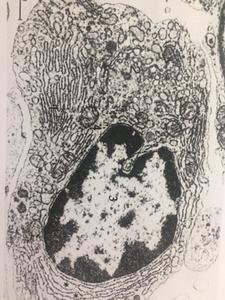18155663
Chapter 5
Zusammenfassung der Ressource
Frage 1
Frage
182. Which of the following definitions refers to osmotic pressure?
Antworten
-
a) the pressure exerted by the solute particles on a semipermeable membrane, due to their thermal motion;
-
b) the pressure exerted on a semipermeable membrane from the solvent particles, due to their thermalmotion;
-
c) the pressure that proteins of blood plasma apply onto the walls of capillaries.
Frage 2
Frage
183. What is the necessary condition for ion diffusion across a semipermeable membrane?
Antworten
-
a) energy supplied from ATP molecules;
-
b) concentration gradient across the membrane;
-
c) electrical gradient across the membrane.
Frage 3
Frage
184. When placed in the following type of solution, cells will retain water and will inflate:
Antworten
-
a) isotonic solution;
-
b) hypotonic solution;
-
c) hypertonic solution.
Frage 4
Frage
This scientist have contributed to the laws of diffusion:
Antworten
-
a) Paul Dirac;
-
b) Adolf Fick;
-
c) Fridtj of Nansen.
Frage 5
Frage
When placed in the following type of solution, cells will lose water and will shrink:
Antworten
-
a) isotonic solution;
-
b) hypotonic solution;
-
c) hypertonic solution.
Frage 6
Frage
Which of the following is a necessary condition for stopping osmosis?
Antworten
-
a) when the pressure of the solute molecules on the semipermeable membrane is equal to the pressure exerted by the water molecules on the other side of the membrane;
-
b) when the pressure from the protein molecules on the semipermeable membrane is equal to the pressure exerted by the water molecules on the other side of the membrane;
-
c) when the pressure on the membrane from the small solute molecules in the intracellular space is equal to the pressure from the protein molecules.
Frage 7
Frage
188. What type of membrane transport is the osmosis:
Antworten
-
a) active;
-
b) passive;
-
c) facilitated.
Frage 8
Frage
189. Vasogenic cerebral edema is characterized by:
Antworten
-
a) inflation of the extracellular spaces;
-
b) inflation of the intracellular spaces;
-
c) vasodilation of cerebral vessels.
Frage 9
Frage
190. The isotonic factor of Van’t Hoff for non-electrolytes is:
Antworten
-
a) 0;
-
b) 1;
-
c) 2
Frage 10
Frage
191. Which of the following is a necessary condition for osmosis?
Antworten
-
a) a non-permeable membrane;
-
b) a semi-permeable membrane;
-
c) ATP energy source.
Frage 11
Frage
192. For a given temperature, solutions with equal concentrations will have equal osmotic pressure.
These solutions are called:
Antworten
-
a) isotonic;
-
b) hypertonic;
-
c) hypotonic
Frage 12
Frage
193. Relative to the blood, physiological solution with 0.9% of NaCl is:
Antworten
-
a) hypertonic;
-
b) isotonic;
-
c) hypotonic.
Frage 13
Frage
194. Which of the following factors do not have an effect on osmotic pressure?
Antworten
-
a) the concentration of solutes;
-
b) the type of solutes;
-
c) the temperature of solutes.
Frage 14
Frage
195. Cytotoxic cerebral edema is characterised by:
Antworten
-
a) inflation of the extracellular spaces;
-
b) inflation of the intracellular spaces;
-
c) loss of water.
Frage 15
Frage
196. Passive membrane transport of uncharged particles is driven by:
Antworten
-
a) electrical gradient
-
b) concentration gradient
-
c) temperature gradient
Frage 16
Frage
197. Osmosis is defined as:
Antworten
-
a) an active transport of solvent molecules across a semipermeable membrane from area of low concentration into area of high concentration;
-
b) a passive transport of solvent molecules across a semipermeable membrane from area of higher concentration into an area of lower concentration;
-
c) an active transport of solute molecules across a semipermeable membrane from an area of low concentration into an area of high concentration.
Frage 17
Frage
198. The following equation describes:
Antworten
-
a) Fick’s law of diffusion;
-
b) Van’t Hoff law of osmosis;
-
c) Nernst equation.
Frage 18
Frage
199. The directed motion of solute particles, leading to equalization of concentrations across a
permeable membrane, without the use of external forces is:
Antworten
-
a) osmosis;
-
b) diffusion;
-
c) reabsorption
Frage 19
Frage
200. What cause the end of net ion diffusion across the membrane?
Antworten
-
a) equalisation of ion concentrations on both sides of the membrane;
-
b) heating up of the less concentrated solution;
-
c) engaging of membrane co-transport.
Frage 20
Frage
201. What are the two types of membrane transport according to the energy requirements?
Antworten
-
a) diffusion and osmoses;
-
b) passive transport an facilitated diffusion;
-
c) passive and active transport.
Frage 21
Frage
202. Which of the following membrane transports is NOT passive?
Antworten
-
a) aquaporins;
-
b) ion channels;
-
c) ion pumps.
Frage 22
Frage
Osmosis across semipermeable membrane occurs due to:
Antworten
-
a) difference in hydrostatic pressure;
-
b) different concentrations of solute;
-
c) different volume of solvent.
Frage 23
Frage
Transport across the cellular membrane without direct use of metabolic energy is called:
Antworten
-
a) passive transport;
-
b) active transport;
-
c) secondary active transport
Frage 24
Frage
Higher (than normal) intracellular concentration of Na+ will lead to:
Antworten
-
a) water moving into the cell;
-
b) water moving out of the cell;
-
c) potassium moving into the cell.
Frage 25
Frage
Which of the following equations refers to Osmotic pressure (per Van’t Hoff):
Where: C-concentration, R-gas constant, T-temperature, V-volume, M-mass.
Antworten
-
a) π = CTV;
-
b) π = MTV;
-
c) π = CRT.
Möchten Sie mit GoConqr kostenlos Ihre eigenen Quiz erstellen? eigenen Mehr erfahren.

